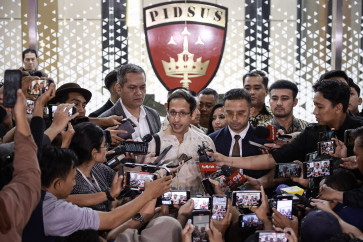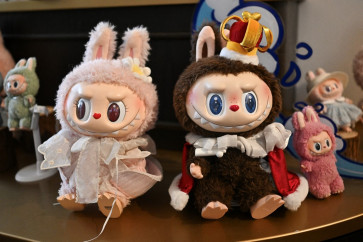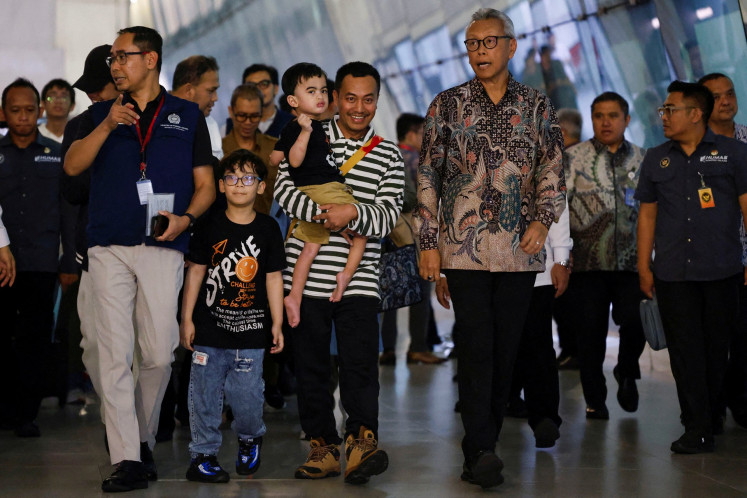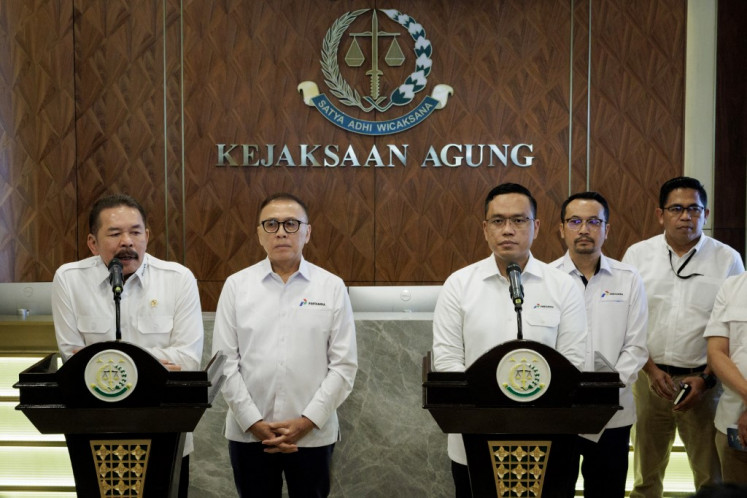Popular Reads
Top Results
Can't find what you're looking for?
View all search resultsPopular Reads
Top Results
Can't find what you're looking for?
View all search resultsAgus Dermawan T: The art of a culture
JP/Willy WilsonA little more than three decades ago, Agus Dermawan T
Change text size
Gift Premium Articles
to Anyone

J
span class="caption" style="width: 398px;">JP/Willy WilsonA little more than three decades ago, Agus Dermawan T. was a free-spirited art student at Sekolah Tinggi Seni Rupa Indonesia “Asri” Yogyakarta and a budding artist.
Today you can call him an author, art critic, art journalist, poet or culturalist. But if you call him a curator, then he begs to differ. Although he curated some notable exhibitions in the past, he insists he never was a professional curator.
The title he’s most comfortable with is art observer. “An art critic assesses artworks based on academic knowledge, which I soon realized wasn’t enough of an aspect to measure the depth of artworks,” he said.
An art observer, he added, takes a more complex approach to assessing art. Aspects such as sociology, anthropology, philosophy, economics, psychology and archeology are taken into consideration when an art observer assesses artworks.
“Tut wuri hangerteni,” said Agus in Javanese, referring to the position of an art observer as someone who “stands behind the art as he tries to comprehend the meaning of it”.
From Rogojampi, Banyuwangi, the 59-year-old was born into a family that appreciated arts. His maternal grandfather, from whom Agus inherited his artistic talent, was a textile designer.
But it was Agus’ businessman father, Goentoro Tantono, who introduced him to the enchanting world of fine arts. As chance would have it, Goentoro was a soccer buddy of legendary painter S. Soedjojono, who in the 1930s moved to Rogojampi to work as a teacher at Taman Siswa.
“Sudjojono founded a soccer team, and my father, who was in his 20s, was a member. Sudjojono often shared stories about his paintings with my father, and as a result, my father grew fond of the art world,” Agus said.
Agus’ love affair with the arts began when his father bought him the first edition of president Soekarno’s painting collection book.
“I was 12 years old when father bought me the book. It was rather expensive, probably equivalent to the price of a tire at that time,” he said, adding that he was captivated by the beauty of the paintings in the book.
Upon completing high school at St. Louis in Surabaya, Agus enrolled in Sekolah Tinggi Seni Rupa “Asri” Yogyakarta (now Institut Seni Indonesia Yogyakarta), and actively participated in numerous exhibitions across the country.
But a 1976 Indonesian painting biennial held at Taman Ismail Marzuki in Jakarta was the last exhibition he took part in. It was David Albert Peransi, a prominent culturalist whom he met at the event that changed the course of his professional life.
“Peransi suggested that painters with a flair for writing should consider working as art writers, to which I secretly agreed. At that time, there were only three bona fide art writers and critics in the country: Sudarmaji, Dan Suwaryono and Bambang Bujono,” he said.
Peransi’s advice was an epiphany of sorts for Agus. And following rumors that he was going to be captured by the military over an allegation that he rebelled against the “permittable” artistic ideology — under Soeharto’s regime, artistic expression on campuses was very restricted — Agus hung up his paintbrush and moved to Jakarta at the urging of friends such as Emha Ainun Najib and Ashadi Siregar. The rest, as he put it, is history.
In Jakarta, Agus quickly established himself as a professional art critic, writing a weekly column for Kompas from 1977 to 1990. He has also added some feathers to his hat in the process, writing six award-winning short stories, poems and cultural essays.
Until this year, Agus has published 2,200 works of literature run in more than 40 publications. Next year when he turns 60, he will publish 60 cultural essays written in the past 10 years. Not bad for a university dropout.
But his rebellious spirit hasn’t disappeared altogether. A reputable art expert in his own right, Agus never once stopped pushing boundaries. But his decisions have always been purposeful.
“Such effort is important because the public needs to understand that there’s more to artworks than just trends,” he explained.
In the 1980s, for instance, when the surrealist genre dominated the market, he introduced the decorative genre to the public. Then, in the 1990s when abstract paintings were hot, he campaigned for realism. The past decade has seen him promoting Balinese paintings despite the market’s enthusiasm for pop art.
But Agus hardly fits the profile of a rebel. His megawatt smile and well-trimmed grey hair, exude a warm personality. He is also a gently humorous and speaks in eloquent full paragraphs with a polite Javanese manner.
For the grandfather of two, the opportunity to know great artists and literary figures personally was an education in itself — a sensory immersion in the world where art is divine. That perspective is also at the core of his professional point of view.
When asked to comment on the Indonesian art world, Agus noted that there’s a lack of confidence in local artists despite the exceptional quality of their works.
“In the past, art enthusiasts knew Affandi, Dullah, Henk Ngantung, Sudjojono and Nashar personally. We understood their inspiration, behavior and train of thought.
“But today, contemporary artists prefer to be considered as laborers, as they always hide behind the curators. Today’s artists must have more confidence in themselves if Indonesia is going to be a dominant player in Southeast Asia,” he said.
Agus and his wife spend a lot of time traveling. He has journeyed to over 100 cities in 30 countries. While traveling, he admitted that he never misses the opportunity to visit local museums and learn about the culture. When not globetrotting, Agus spends time watching movies at the cinema.









